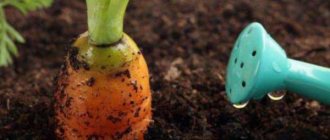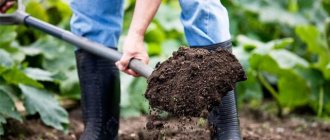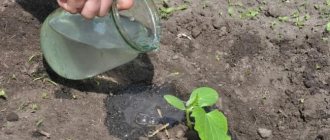What does feeding affect?
It is a mistake to think that carrots grow on their own and do not need additional nutrients. But in order to grow a high-quality, beautiful and tasty carrot crop, you will have to try very hard.
Soil quality plays an important role. The root crop grows well in loose, air- and water-permeable soil. But it grows poorly on clay, loam, and peat soils.
You can apply different fertilizers, both mineral and organic. Carrots respond well to feeding throughout the season. Some are added when preparing the soil, others during planting, and others during growth.
Substances such as sawdust, sand and turf soil help make the soil lighter.
Wood ash, chalk and dolomite flour reduce acidity.
Nitrogen, phosphorus and potassium fertilizers are applied to improve productivity and saturate the soil with nutrients.
Even fertile lands will not be able to produce enough quality fruits if you plant a lot of root crops. Timely application of fertilizing affects:
- amount of harvest;
- sweetness, richness of taste;
- external qualities, presentation. The carrots turn out smooth and bright;
- resistance to diseases and pests, adverse conditions;
- keeping quality and transportability.
Nitrogen-containing substances increase the amount of carotene, increase the keeping quality and growth of root crops. Sweetness depends on phosphorus and potassium. If there is less of it, then the carrots will taste bland.
Nitrogen fertilizer
But it is very important not to overdo it. From an excess of fertilizers, both organic and mineral, nitrates can accumulate in root vegetables, and the vegetable can begin to rot while still in the ground.
Soil preparation and sowing
Spring work is carried out regularly from the moment the snow melts. Farmers know that it is during this period that a number of comprehensive measures should be carried out to obtain high yields for all types of plants, and not just carrots.
You can use both store-bought drugs and folk remedies. Next, strictly follow the deposit calendar.
Setting the stage
To improve soil quality, it is advisable to use organic fertilizers. They are beneficial in any case, regardless of whether they were introduced in the spring or autumn.
The advantage of organics in this regard is the ability of long-term decomposition. Therefore, in the fall, substances are added under the carrots that can loosen and nourish the soil. The type of soil plays a role in application, since the loosening agents most needed are:
- loamy;
- clayey;
- heavy soils.
Sand and sawdust, as well as humus and compost, are suitable for this. Fertilizers are calculated by square meters: 1 sq. m. = 5-7 kg of organic matter. If the soil is determined to be acidic, then chalk and ash are used.
Important! If carrots are planted in open ground, then you should definitely check the acidity: pH should not be lower than 5.5. Provided that the mark is above 6.5, you should not wait for a juicy, sweet vegetable.
Alkalinization of the land plot will be required. Experienced farmers warn that the soil type test should be carried out simultaneously in different parts of the land plot, since acidity levels often differ.
What do carrots like?
Carrots respond best to old, rotted organic matter. Therefore, it is best to add natural substances in the fall when digging future beds. Plus, this will save you from unnecessary fuss in the spring; all that remains is to sow the seeds.
Carrots love light soils, since heavy ones do not allow enough air to penetrate, plus they impede its growth and contribute to curvature. We have already written earlier why carrots grow gnarled and horned.
For good root development, the following components are required:
- Potassium is needed for growth and taste, and sufficient oxygen also improves immunity. Thanks to it, carrots become tender and aromatic.
- Nitrogen helps increase protein and carotene.
- Carrots love phosphorus, which promotes root growth and provides complete nutrition. This fertilizer can be applied in unlimited quantities. It is needed for sweetness and juiciness.
- Boron helps strengthen immunity and pollination. It is needed for juiciness and taste.
Step-by-step instructions on how to fertilize
Paste
Paste is a very convenient and effective fertilizer for seeds, especially carrots. On average, one liter of paste is enough to sow 10 g.
There are the main stages of laying the paste:
- Before sowing, the furrows in the selected area must be well watered.
- The finished paste is packaged together with carrot seeds in a plastic bottle with a hole in the lid, a pastry syringe with a large nozzle, etc.
- Apply or pour (depending on the resulting composition) paste with seeds into these grooves.
- Immediately after sowing, the beds must be covered with a small layer of loose soil (no more than 2 cm in thickness).
- To further preserve moisture in the soil, the bed is covered with film or other non-woven material until carrot sprouts appear.
Bor
- When fertilizing carrot seeds with boric acid, you should use hot water heated to +45...+50 C.
- Completely dissolve 1 tsp. powder in 1 liter of warm liquid, and then bring the total volume with water at room temperature to 10 liters.
- The first feeding of the fruit should be done in mid-July, when the root part begins to form.
- The fruit should be fertilized a second time in the first half of August, when the root crops begin to ripen.
Eggshell
- Before fertilizing carrot seeds, the eggshells must be dried and walked over them with a rolling pin.
- It is necessary to make grooves for future root crops and water them in sufficient quantities.
- Pour the resulting egg powder into them, and sprinkle the seeds on top. Then sprinkle with earth and press down with a stick or hand.
Signs of nutritional deficiencies
You can tell that a carrot is suffering from a lack of nutrients by its limp and frail tops. It becomes pale green in color, and sometimes even turns white. Read about other reasons for poor carrot growth here.
Due to a lack of potassium, the tops become grayish and the edges burn. The reason is not the strong sun.
A lack of nitrogen is manifested by weak and slow growth of the above-ground parts. Also, due to oxygen deficiency, carrots do not gain sweetness and become rotten. And the fruits themselves turn out crooked and small. You can check this by pulling out a couple of vegetables for tasting.
Preparatory work before sowing carrots
Selecting a location
Carrot beds should be located in an open area with continuous sunlight during the day. A light-loving culture will not be able to fully develop in shade or partial shade. Without sufficient heat and light, the fruit will be tough, thin in shape and less juicy in taste.
This vegetable also has its own soil requirements. It must be loose and fertile, drained, with good aeration, neutral in composition, loamy or sandy loam, with good moisture permeability. On heavy and dense soils, there is a risk of fungal diseases appearing in adult plants and negatively affecting the taste of fruits.
Preparing the soil in the beds
Preparatory work on the selected site begins in the fall. The soil is carefully dug up, additional components are added to increase fertility and looseness - compost, peat, coarse river sand and rotted cow manure (about half a large bucket of manure for each square meter of land).
In areas with heavy and dense soils, it is recommended to add wet sawdust to the ground when digging. They are pre-soaked in a solution of three liters of water and three tablespoons of urea. About three kilograms of sawdust are added for every square meter.
Accounting for predecessor plants
Crop rotation is of no small importance in the growth and development of crops. It is imperative to take into account what plants grew in this bed in the previous season. For example, carrots can only be planted in the same place after three or four years.
A good harvest of orange root vegetables can be obtained from potatoes, cucumbers, tomatoes, onions, beans and peas, beets, zucchini, pumpkin, cabbage and garlic.
For example, carrots can only be planted in the same place after three or four years. A good harvest of orange root vegetables can be obtained after potatoes, cucumbers, tomatoes, onions, beans and peas, beets, zucchini, pumpkin, cabbage and garlic.
Neighborhood with other cultures
It is recommended to alternate carrot beds with onion plantings, as they help each other repel their most common pests - onion and carrot flies. However, their very close proximity is undesirable due to the different volume and frequency of watering.
Gardeners also welcome the joint planting of carrots with lettuce, parsley, and radishes.
Preparing carrot seed material for sowing
Such seed has already undergone certain processing, the surface of the seeds is protected by a special coating, and they must be sown dry so that this protective shell is not damaged.
Seeds collected independently or borrowed from friends and relatives must be prepared for sowing activities.
This preparation can be carried out in two ways.
First way:
- the seeds are soaked in water at a temperature of about thirty degrees for three to four hours;
- after this, the seed is placed between two damp cloth or gauze napkins and constant humidity is maintained until sprouts appear (at twenty-five to twenty-seven degrees);
- Next, the material must undergo hardening procedures at a temperature of five to seven degrees (possibly in the refrigerator) for one week, after which the seeds can be sown in open ground.
Second way:
- the seeds are kept in a container with warm water for 24 hours;
- then place them for fifteen to twenty minutes in a manganese solution (one hundred milliliters of water and one gram of manganese) and wash with plain water;
- after this, the seeds are dipped in a stimulating solution for twenty-four hours, prepared on the basis of the drug “Epin” or “Epin - extra” (five to six drops per half liter of water), now they can be sown.
How to feed carrots in open ground?
Mineral and organic fertilizers are suitable for feeding carrots in open ground. They are equal in efficiency. The choice in one direction or another is outweighed only by the personal preferences of the gardener and his capabilities. Traditional medicines are always at hand.
Organic fertilizers
Carrots don't like fresh organic fertilizers. It does not extract useful substances from them, plus it begins to rot. Therefore, you need to add organic matter in the fall so that it has time to rot over the winter, or feed it with solutions of already fermented organic matter.
When preparing the beds, add manure, compost and humus. A large amount of fertilizer in the fall will allow you not to add it before planting in the spring, not to waste time on this, but simply sow the seeds.
The following work great as an organic fertilizer:
- diluted chicken droppings in a ratio of 1 to 10; pigeon droppings are also suitable;
- rotted manure or its solution;
- compost in slurry form. How to make compost correctly, read here.;
- wood ash. It is rich in potassium, which increases sweetness and shelf life.
Mineral fertilizers
Mineral and complex fertilizers are more preferable for carrots. They are easier to calculate and apply, plus they contain all the necessary substances. Feeding begins from the second growth phase.
Carrots are fed:
- potassium chloride, since this is one of the few plants that tolerates chlorine well;
- potassium salt;
- potassium nitrate;
- azofoskaya;
- nitroammophoska;
- urea and saltpeter;
- potassium sulfate.
Such drugs as Rastvorin, Kristalon, Kemira, Fertika, Nitrophoska have proven themselves well.
Feeding carrots with potassium monophosphate
Potassium is one of the key elements for carrots. It is this element that helps to get a rich harvest.
Potassium monophosphate works great as a top dressing. This is a complex mineral fertilizer containing about 50% phosphorus and 33% potassium. Thanks to it, the quality of the crop and the shelf life of the root crop increase. The drug is applied in the summer or during planting. It works especially well in non-hot, humid summers.
The drug is available in granules or powder. But both are used only in solution, since in solid form it does not work and does not provide nutrients to vegetables. But you shouldn’t overdo it, since using it more than twice a season provokes the growth of weeds.
Potassium monophosphate solution – 30 g per 10 l, suitable for watering and spraying vegetables. Dilute the drug according to the instructions and apply it to the plants. The first feeding is when root crops form, the second – a month after the first. It would be useful to read the article about watering carrots.
For foliar spraying, dilute 2 g per 10 liters.
How to feed carrots with potassium chloride
Carrots are practically the only vegetable that tolerates chlorine well. Therefore, it can be fed with potassium chloride. This is one of the most important elements because it:
- strengthens the root system, stimulates its growth;
- improves the growth of the aboveground part of the plant;
- increases immunity and resistance to external factors and diseases;
- enhancing sugar content, taste qualities of root vegetables and external characteristics.
Carrots are seasonally fed with potassium chloride according to the instructions on the package. Before planting, make furrows to a depth of 8 cm, pour potassium chloride powder into them in a thin stream, sprinkle with soil and plant the seeds. When the carrots reach the place where the fertilizer is located, it will already decompose in the soil and will become available for nutrition.
Feeding carrots with folk remedies
If it is not possible to use mineral preparations, folk remedies will do. They are no less effective. But with them it is more difficult to calculate the dosage.
Feeding with boric acid
Boron is needed for complete carbohydrate and protein metabolism. Carry out foliar feeding by dissolving a teaspoon of boric acid in a liter of warm water. Then dilute the solution in a liter of water.
Spray the plants in mid-July, when the root crop is formed, and in early August, when the carrots finally ripen.
Feeding carrots with yeast
Stir the yeast powder from the bag into 2-3 liters of water. Then add ash and dilute it all in a bucket of water. On a dry and warm day, water the carrots with a nutrient solution to add nitrogen and phosphorus to the soil using the solution and support the microflora.
Fertilizing carrots with ash
The simplest and most effective way to feed. You can fertilize in two ways:
- scatter 250 g per 1 square meter over the beds. m.;
- Dissolve 100 g of ash in a bucket of water, leave for 12 hours and water the plants.
This fertilizer provides carrots with magnesium, potassium and sodium, plus prevents pests.
Is it possible to feed carrots with salt?
Salt can be used as a source of sodium and pest control. It's better to use sea salt. It helps against carrot flies and wireworms. Carry out the treatment up to 3 times: immediately after germination and then every 14 days. To do this, dissolve a tablespoon in a bucket of water.
Foliar fertilizing with iodine
Immediately after germination, feed the root crop with iodine solution: 15-20 drops per bucket of water. Water the beds in the morning or evening when there is no scorching sun.
Is it possible to feed carrots with manure?
To feed carrots, you can only use rotted manure or add it to the beds when preparing in the fall. Water the rows with a solution (1:10) in the morning or evening, fertilize when seedlings emerge and during active growth of the fruit.
Rules for applying fertilizers
The main rule is the norm. The old hackneyed wisdom, which calls for it to be better to undersupply than to overdose, is relevant for all types of feeding, but especially for mineral ones.
When preparing beds
At this stage, it is important to remember that only rotted organic matter is added, i.e. one that has been ripening for at least a year. You should not expect that in the fall you can dig up fresh manure or bird droppings, which will be in the right condition by spring. This mistake will lead to the death of crops, since overheating - a process of high temperatures - does not occur in winter. The soil into which fresh organic matter was added is ready to accept root crop seeds only a year after fertilization.
When sowing carrots
Add granules of mineral fertilizers immediately before sowing and mix them with the soil so that the seeds do not come into contact with the fertilizer - burns are possible. It is preferable to add mineral complexes during preparation - 15-20 days before sowing, and use organic matter directly when planting the seeds.
Feeding during the growing process
As soon as the seedlings have appeared, the first feeding can be carried out. In order not to burn the sprouts or accidentally damage the delicate roots, water exclusively in the rows or around, but not closer than 8-10 cm to the plant. The granules, and this is very important, are embedded in the soil after good watering.
Root and foliar feeding (dusting, irrigation) is alternated, achieving the best result - a rich harvest of sweet, healthy carrots that can maintain freshness until the new planting season.
( 1 ratings, average: 1.00 out of 5)
How to fertilize carrots for root growth
Superphosphates and nitrophosphates, potassium salt and ammonium nitrate accelerate growth. Apply mineral fertilizers according to the instructions. As a rule, 1-1.5 tbsp is enough. spoons per 10 m of bed.
Work well:
- Mortar;
- potassium magnesium;
- urea;
- superphosphate.
Fertilizers for carrots when planting
When planting carrots, grooves are made into which any potassium salts that do not contain chlorine are added, since this microelement inhibits the crops of this vegetable plant.
You can also “saturate” the seeds themselves with fertilizers before planting them in the following ways:
Dissolve tbsp in a liter of water. l. wood ash, place the seeds in a gauze bag into the resulting solution and leave for 24 hours. The soaked seeds then need to be dried and can be planted in the beds.
First, the paste is boiled with wheat flour, then it is cooled and mineral fertilizers for carrots are stirred in it, seed is added, a regular pastry bag (or syringe) is filled with the resulting mixture and squeezed into the prepared grooves.
Stages of applying fertilizers for carrots
It is very important to pay attention to the stages of fertilizing, because how much fertilizer to apply is no less important than fertilizing carrots. Excess or late application can have the opposite negative consequences.
What fertilizers should I add to the carrot bed?
When planting and preparing beds, apply potash fertilizers without chlorine. Despite the fact that carrots carry it, it oppresses seedlings, and the harvest cannot be expected. Rotted manure and compost are also added to the garden bed in the fall.
When digging future beds, add:
- superphosphate;
- potassium sulfate;
- potassium magnesia.
In spring you can add ammophos 15 g per 1 sq. m. m, azofoska 60 g per 1 sq. m, potassium magnesia 30 g per sq. m.
Fertilizers for carrots when planting
When planting in spring, add:
- wood ash. A tablespoon is enough for one furrow.
- potassium and nitrogen supplements (0.5 teaspoon).
- boric acid (a teaspoon per liter of warm water) and nitrophoska.
Feeding after emergence
The next feeding occurs after the first shoots appear and true leaves form. Apply fertilizer after thinning to avoid wasting fertilizer on plants that will not produce a harvest.
The following composition is used:
- a tablespoon of ammonium nitrate;
- 1.5 table. spoons of superphosphate and potassium salt.
The resulting mixture is poured onto beds up to 10 m long.
How to fertilize carrots in July
July feedings have the following features:
- Do not use fresh manure and compost;
- from mid-July, you cannot use fertilizers with nitrogen so that the carrots do not grow only green mass;
- It is more important to loosen and water carrots than to fertilize them regularly. This vegetable is not the most demanding in terms of nutrients.
In July it is recommended to apply:
- potassium to strengthen the root system and immunity of the vegetable;
- phosphorus supplements (double superphosphate, phosphate rock) for core hardness and sweetness;
- boron to strengthen the vegetable, juiciness and sweetness.
Apply mineral fertilizers according to the instructions; an overdose has no less detrimental effect on the growth and development of the vegetable, as does the lack of fertilizing.
Feeding carrots in August
In August, carrots need phosphorus, boron and potassium. Therefore, the following traditional methods are suitable at this time:
- ash;
- boric acid;
- yeast (powdered or lump).
The following are suitable mineral fertilizers:
- Ammonium nitrate;
- Potassium chloride;
- Potassium monophosphate;
- Superphosphate.
You can use complex fertilizers Autumn, Kemira-Universal, Mortar, etc.
What can you feed in September?
As September approaches harvest time, additional nutrients are just as effective at this time.
During this period, the vegetable gains juice, sweetness, and vitamins, so add Kemira Universal and Agricola 4 more actively.
Among the popular methods that are effective:
- nettle infusion – ferment the herb in warm water for 2-3 days;
- wood ash;
- dry and lump yeast;
- iodine;
- a solution of fermented chicken manure in a ratio of 1:10, leave for 5 days.
How to fertilize carrots before harvesting
Fertilizer is necessary to reduce nitrates in vegetables, which can accumulate not only due to minerals, but also organic matter.
Carry out this feeding of carrots a month before harvest.
Apply:
- wood ash;
- potassium sulfate;
- potassium chloride.
You will find the rules for harvesting carrots in this article.
About the importance of feeding
The composition of the soil and the presence in it of a sufficient amount of nutrients and microelements are of great importance for the growing season of carrots. The quality and taste of the root crop directly depend on this. With a nutritional deficiency, carrots lag behind in development, become deformed, and yield is significantly reduced.
Therefore, when sowing crop seeds, it is important to prepare the soil and fill it with the necessary elements. In the period from sowing seeds to harvesting, at least 2-3 feedings are expected - based on mineral or organic fertilizers and folk remedies. Their application must be correct and timely: during sowing and in certain vegetative phases of carrot growth.
Possible consequences of violating the rules for feeding carrots
Due to violation of feeding rules - most often an overdose, the following negative consequences may occur:
- increased growth of tops rather than root crops - excess nitrogen;
- curvature and disorder of the fetus - lack of nutrients;
- small or too large root vegetables;
- loss of taste: dry, hard, unsweetened - lack of phosphorus, potassium;
- cracking;
- damage by diseases and pests.
You can also lose your harvest completely, since fresh organic matter depresses the plant. Plus, shelf life and keeping quality suffer. They are significantly reduced.
What is needed and the consequences of wrong actions
For healthy, active growth of carrots, it is necessary to take into account not only the time of watering, thinning or other methods of soil treatment. It is necessary to determine which element is missing. Signs of deficiency will also help to correctly apply knowledge of fertilizer application in practice.
In total, there are three stages of cultural development. And the first is that carrots gain green mass. To prevent damage to the immune system, the plant takes large amounts of nitrogen, potassium and phosphorus from the soil.
If there is a lack of one of them at subsequent stages of development, a deterioration in appearance, infection with infectious and bacterial diseases, and an inability to withstand pest attacks occurs.
To get a good carrot harvest you need:
- Manganese, boron. They promote the pouring of root crops, while ensuring firmness and full appearance. Prevents rotting in the middle. Additionally, making carrot juice sweeter, increasing the shelf life. Deadline for submission: in July.
- In summer, it is necessary to replenish the supply of phosphorus. The element contributes to the formation of culture, namely fruits. Necessary for root growth, sweetness, tip rounding, and increased density.
- Potash fertilizers should be applied throughout the growing season. With their help, metabolism is stabilized, the process of photosynthesis is optimized, and the aerial part is formed. Potassium helps increase juice.
People try not to apply nitrogen fertilizers to carrots unless the soil is in dire need of the element and signs of nitrogen starvation are noted. The element is recommended as the first fertilizing, as it increases the green part, and not the root crop.











